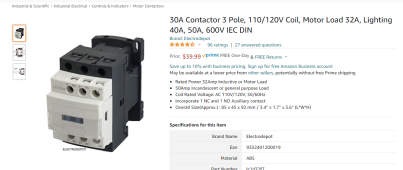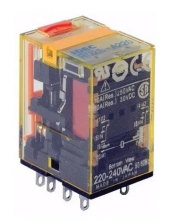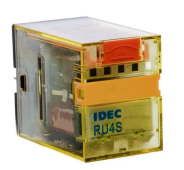WoodsieLord
New Member
** before I forget: my grid runs at 220VAC, single phase. **
I have bought an 8 pin relay. The purpose is this: I want a small fridge to run on solar by day and use the grid by night. This would save power during the day and preserve my already-very-small lead acid bank when no power is being harvested.
The fridge load is quite small (150W ~ 200W, when running) and I've been running it off solar for quite some time without issues (except that the bank gets drained a bit too much for my liking).
Relay characteristics:
- It states it can switch 10A @ 220V AC.
- The coil is also rated at 220V AC.
- Not stated, but it's supposed to be designed for continuous use.
- It came with a DIN socket.


I installed the Relay so that when the coil is not energized, the two Normally Closed pins connect the grid to the fridge. When the coil is energized, the fridge gets connected to the inverter through both Normally Open pins.
The problem: When energizing the coil, the relay goes "zombie" after a while (a while being between 20 min ~ 1 hour sometimes a bit more).
'zombie': The relay won't close normally open nor normally closed either!. (fridge powers off)
I've tried many times, leaving the relay in the 'zombie state ' from a few minutes to at least 3 hours. The relay gets a bit hot but not to the point of burning my fingers.
When I don't energize the coil and the fridge runs on the normally closed pins, the relay works cool indefinitely.
The relay quality is not great, but I can't seem to find a better one.
now...
. . . If the relay could not handle the current, it would overheat even when the coil is off and runs on the normally closed pins.
. . . if the coil was mislabeled and was actually 24V or 12V, using it with 220V for such long test periods would have burned the coil. But the coil keeps coming back to life after I let it cool down.
Since this type of product features no kind of warranty, I felt adventurous: I removed the plastic casing and drilled lots of holes to let it vent. This ramped up the working time a bit (previously it would go zombie after ~20 minutes, now it might take 1 hour or so).
Any ideas on what's going on or a workaround? Thanks in advance!
I have bought an 8 pin relay. The purpose is this: I want a small fridge to run on solar by day and use the grid by night. This would save power during the day and preserve my already-very-small lead acid bank when no power is being harvested.
The fridge load is quite small (150W ~ 200W, when running) and I've been running it off solar for quite some time without issues (except that the bank gets drained a bit too much for my liking).
Relay characteristics:
- It states it can switch 10A @ 220V AC.
- The coil is also rated at 220V AC.
- Not stated, but it's supposed to be designed for continuous use.
- It came with a DIN socket.


I installed the Relay so that when the coil is not energized, the two Normally Closed pins connect the grid to the fridge. When the coil is energized, the fridge gets connected to the inverter through both Normally Open pins.
The problem: When energizing the coil, the relay goes "zombie" after a while (a while being between 20 min ~ 1 hour sometimes a bit more).
'zombie': The relay won't close normally open nor normally closed either!. (fridge powers off)
I've tried many times, leaving the relay in the 'zombie state ' from a few minutes to at least 3 hours. The relay gets a bit hot but not to the point of burning my fingers.
When I don't energize the coil and the fridge runs on the normally closed pins, the relay works cool indefinitely.
The relay quality is not great, but I can't seem to find a better one.
now...
. . . If the relay could not handle the current, it would overheat even when the coil is off and runs on the normally closed pins.
. . . if the coil was mislabeled and was actually 24V or 12V, using it with 220V for such long test periods would have burned the coil. But the coil keeps coming back to life after I let it cool down.
Since this type of product features no kind of warranty, I felt adventurous: I removed the plastic casing and drilled lots of holes to let it vent. This ramped up the working time a bit (previously it would go zombie after ~20 minutes, now it might take 1 hour or so).
Any ideas on what's going on or a workaround? Thanks in advance!






